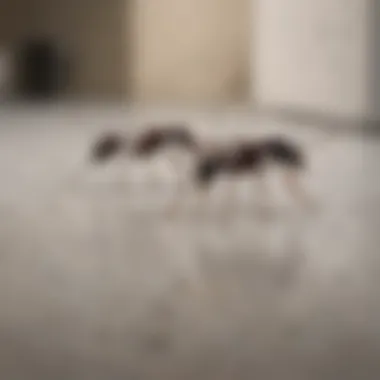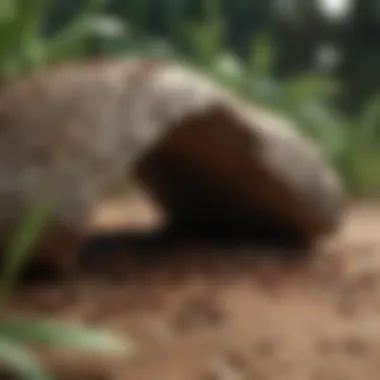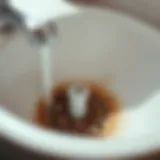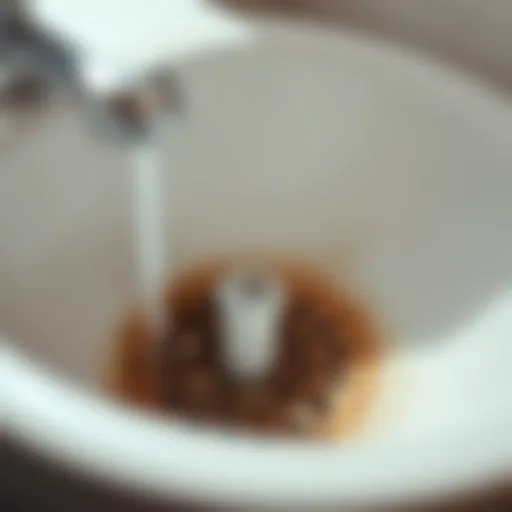Effective Strategies to Prevent Sugar Ants in Your Home


Intro
Sugar ants are a common nuisance for many households. They are small but persistent, often invading kitchens and other areas where food is present. Understanding their biology and behavior is crucial to prevent these pests from becoming unwelcome guests. This article aims to provide clear, actionable strategies to keep sugar ants at bay. By exploring their habits and identifying key entry points, homeowners can effectively manage their living spaces, creating a pest-free environment.
Key Insights and Trends
Understanding Sugar Ant Behavior
Sugar ants are attracted to sweet substances. They can travel surprisingly long distances to find food sources. Their foraging patterns are highly organized, which means once they find a food source, they will return with others. By understanding this behavior, one can take proactive steps to mitigate infestations.
Common Entry Points
Sugar ants can enter homes through tiny cracks or openings. They often exploit gaps around windows, doors, and utility lines. Recognizing these vulnerable areas can be the first step in prevention. Regular inspection can identify potential entry points before they become problematic.
Practical Tips and How-To Guides
Maintain Cleanliness
Keeping a clean home is one of the most effective deterrents against sugar ants. Here are important tips:
- Wipe down counters and surfaces regularly to remove any food residues.
- Store food in airtight containers to avoid attracting ants.
- Sweep and vacuum floors frequently, especially in kitchens and dining areas.
Seal Entry Points
To minimize the chances of ants entering, consider the following:
- Inspect windows and doors for gaps, and use caulk to seal any openings.
- Ensure that screens on windows and doors are intact, without tears.
- Look at your home's foundation for cracks and seal them appropriately.
Use Natural Repellents
Several natural options can repel sugar ants effectively. These include:
- Vinegar: A solution of equal parts vinegar and water can be used to wipe surfaces.
- Essential oils: Peppermint or tea tree oil diluted in water can deter ants when applied to entry points.
"A proactive approach to cleanliness and preventative measures greatly reduces the risk of sugar ant infestations."
Chemical Solutions
If natural methods are insufficient, chemical repellents can be effective. Common products include:
- Terro Liquid Ant Baits, which attract and eliminate ants.
- Raid Ant and Roach Killer, suitable for immediate action.
Ongoing Maintenance
Preventing sugar ants requires continuous effort. Consider establishing a seasonal cleaning schedule that includes checking for entry points. Remind homeowners that persistence is key. Regular vigilance can make a significant difference.
By implementing these strategies, individuals can safeguard their homes from sugar ants. Following the outlined steps cultivates not only a pest-free environment but also a more hygienic living space.
Understanding Sugar Ants
Understanding the nature of sugar ants is crucial when it comes to preventing infestations in your home. This section focuses on their biological traits, habitat preferences, and feeding habits. By gaining insight into these aspects, homeowners can develop effective strategies for minimizing the risk of these pests invading their living spaces. The relevance of this understanding cannot be overstated, as it lays the groundwork for implementing practical prevention methods.
Biology and Lifespan
Sugar ants, formally known as Camponotus consobrinus, are fascinating creatures characterized by their unique biology. Adult sugar ants can vary in size, often reaching 8 to 15 mm in length. Their appearance usually includes a shiny black body with yellowish markings.
The lifespan of a sugar ant colony can extend up to several years, with the queen living the longest—often more than a decade. This longevity allows colonies to grow in number, making infestations a persistent concern for property owners.
Habitat and Nesting Preferences
Sugar ants favor moist environments, typically nesting in soil, under rocks, or within decayed wood. They are particularly drawn to areas that provide shelter and easy access to food sources.


Common nesting sites include:
- Gardens and lawns
- Under debris or logs
- Inside wall voids and cavities
Understanding these preferences is vital for effective outdoor control strategies. Keeping these areas clean and monitored can deter sugar ants from establishing nests in proximity to your home.
Feeding Habits
Sugar ants are primarily attracted to sugary substances, which is reflected in their name. Their diet consists mainly of:
- Nectar from flowers
- Honeydew produced by aphids
- Sugary foods left exposed in homes
This foraging behavior means that a sweet drink or leftover crumbs can quickly attract them inside. Recognizing their feeding habits enables homeowners to identify potential food sources in their kitchens or dining areas that may attract sugar ants.
Understanding their biology, habitat, and feeding habits provides key insights necessary for effective prevention.
Identifying Sugar Ant Infestations
Understanding how to identify sugar ant infestations is crucial for effective prevention and control. Recognizing the signs early can help homeowners take proactive steps before an invasion becomes widespread. Sugar ants can adapt to various environments and may enter homes in search of food, especially sweet substances. By identifying feeding patterns and nesting behaviors, one can minimize the risk of an extensive infestation.
Effective identification not only helps in determining the extent of the problem but also aids in selecting the most appropriate strategies for management. Homeowners who can spot the early warning signs and understand the common entry points will find it easier to keep their living spaces pest-free. This vigilance is essential for maintaining a clean and comfortable environment.
Signs of an Infestation
Detecting sugar ants is often not as straightforward as observing the insects themselves. Here are some common signs that indicate an infestation:
- Ant Trails: Look for continuous lines of ants moving in and out of your home. These trails are frequently visible near food sources.
- Sighting of Worker Ants: Seeing lone worker ants may suggest a nest nearby. They are typically small, about 0.1 to 0.2 inches in length.
- Nest Locations: Sugar ants prefer to build nests in moist places like under damp soil, inside wall cavities, or even in potted plants. If you find small dirt piles or substrate that seems out of place, this could be a nest.
- Food Sources: If sugar ants are consistently present near food items — especially sweets like fruit or candy — then you likely have an infestation. They will leave behind pheromone trails leading back to their nests.
- Damage to Food Packaging: Small holes or perforations in food wrappers or containers may indicate that ants have accessed your stored food.
Identifying these signs promptly can help you take necessary action before the situation escalates.
Common Entry Points
Sugar ants can gain access to your home through various entry points. Recognizing these can assist with preventative measures. Here are several common ways sugar ants might enter your residence:
- Cracks and Crevices: Gaps around windows and doors often provide easy access. Check the frames for signs of wear or misalignment.
- Plumbing and Electrical Outlets: Sugar ants often utilize openings around plumbing fixtures and electrical outlets as pathways into the interior.
- Openings from Utility Lines: Ants can exploit spaces where pipes and wires enter the house. Inspect these areas for potential gaps.
- Ventilation Openings: Vents that lead to outside air can serve as entry points, especially if not properly screened.
- Unsealed Gaps in Foundations: Loose or unsealed components of the home’s foundation can provide an undocumented gateway for sugar ants.
Recognizing these entry points allows homeowners to implement strategic sealing measures, significantly reducing the likelihood of an infestation.
Preventative Measures
Preventing sugar ants from invading your home requires a strategic approach. Understanding their behaviors and habitat preferences helps in implementing effective measures. The significance of preventative measures lies not only in reducing the presence of sugar ants but also in minimizing the chances of future infestations. Homeowners must recognize that avoiding sugary residues and creating physical barriers can drastically decrease the allure for these insects. Consistent and proactive actions can save time, effort, and financial resources in the long run.
Maintaining Cleanliness
Keeping your home clean is a fundamental aspect of preventing sugar ants. These pests are often attracted to food scraps, spills, and residues that remain throughout the week. Regular cleaning should encompass the entire home, including kitchen counters, floors, and dining areas.
- Wipe down surfaces daily to remove any traces of food.
- Vacuum frequently to eliminate crumbs and debris.
- Empty trash cans often and ensure they are sealed tightly.
Avoid leaving dirty dishes in the sink for extended periods. Also, ensure that pet food is stored away promptly after feeding.
Sealing Cracks and Gaps
Sugar ants can enter homes through very small openings. Therefore, inspecting and sealing cracks and gaps is a critical step in prevention. This can involve checking around windows, doors, and foundations.
- Use caulking for small cracks and gaps in walls and around moulding.
- Install door sweeps at the bottom of exterior doors to block entry.
- Check window screens for tears and replace or repair them to ensure they are airtight.
These measures not only block sugar ants but also improve energy efficiency in the home.
Proper Food Storage
How food is stored can attract or repel sugar ants. Keeping food in airtight containers is essential. This makes it difficult for ants to access food sources.


- Store pantry items like sugar, flour, and grains in thick plastic or glass containers.
- Seal leftover food in airtight bags or containers before placing it in the fridge or freezer.
- Limit snacks left out on counters and tables.
Even minor alterations in food storage practices can effectively deter ants by reducing the scent trail that draws them inside.
Managing Outdoor Areas
The outdoor environment plays a significant role in attracting sugar ants. Creating a less hospitable space can limit their chances of entering your home.
- Keep the yard clean by removing debris like leaves and twigs where ants can nest.
- Trim bushes and branches away from the house to prevent ants from using vegetation as a bridge.
- Create distance between gardens and the home by using gravel or wood chips. This barrier makes it harder for ants to travel from their nests into your living space.
A focused effort on outdoor areas complements the indoor efforts, establishing a comprehensive barrier against sugar ants.
Natural Deterrents
Natural deterrents are an essential part of any strategy aimed at preventing sugar ants from invading homes. Unlike chemical solutions which may have harmful side effects, natural methods provide a safer alternative for households, especially those with children and pets. These alternatives are typically easy to use and often more environmentally friendly. Utilizing natural deterrents can minimize the risk of toxic exposure while still effectively managing pest concerns.
Essential Oils as Repellents
Essential oils have gained attention as effective repellents for sugar ants. Oils such as peppermint, tea tree, and eucalyptus have properties that can disrupt the scent trails used by ants. When ants enter your living space, they rely on pheromones to communicate and find food sources. By applying essential oils in strategic locations, you can interfere with these trails, making it difficult for them to navigate.
For effective use, consider the following:
- Dilution: Mix a few drops of your chosen essential oil with water in a spray bottle. A typical ratio is about 10 to 15 drops per cup of water.
- Application: Spray the solution near entry points, like windowsills and door frames.
- Frequency: Reapply every few days or after cleaning to maintain effectiveness.
"The natural approach not only addresses pest problems but also offers a healthier environment for your family."
In addition to their repellent properties, essential oils can impart a pleasant scent to your home. However, be cautious regarding sensitivity; some individuals may have allergies to specific oils. Always test a small area beforehand.
Homemade Traps
Creating homemade traps provides another method for managing sugar ants without resorting to commercial products. These traps can be made with simple household items, effectively luring ants to a designated area where they can be contained.
Here are common techniques for making effective traps:
- Sugar and Water Trap:
- Borax and Sugar Trap:
- Vinegar Trap:
- Mix equal parts sugar and water to create a sticky solution.
- Place the mixture in a shallow dish or jar. The sugar attracts the ants, and the sticky consistency prevents them from escaping.
- Combine one part borax with three parts sugar, and add a little water to form a paste.
- Place small dollops of this mixture in areas where you have seen ant activity. The sugar attracts ants, and borax works to eliminate them over time. Ensure this trap is kept out of reach of children and pets, as borax can be harmful if ingested.
- Mix equal parts vinegar and water in a bowl.
- Set the bowl where you frequently observe ants. The strong smell of vinegar disrupts their scent trails and can deter them from moving further into your home.
Chemical Solutions
Chemical solutions play a crucial role in preventing and managing sugar ant infestations. While maintaining cleanliness and utilizing natural deterrents are effective methods, the use of chemicals can provide a more immediate impact when infestations become overwhelming. It is essential to understand the specific products designed to target sugar ants and how they function. Chemical solutions can not only eliminate existing populations but also deter new arrivals, ensuring a pest-free environment.
When considering chemical solutions, several factors should be taken into account. Safety is paramount, as many insecticides contain compounds that may pose risks to humans and pets. Additionally, the effectiveness and longevity of the chemicals are vital considerations. Choosing the right product can lead to successful treatment and prevention, reducing the likelihood of further infestations.
Insecticides Targeted for Sugar Ants
Insecticides specifically formulated for sugar ants often contain active ingredients that disrupt the biological functions of the ants. Products like Raid Ant and Roach Killer or Ortho Ant Killer are common choices among homeowners. These products generally come in various forms including sprays, granules, and dusts, each suited for different situations.
Sprays are ideal for immediate application on visible ants, while granules can be spread around the perimeter of the home to create a barrier. Dust formulations can penetrate into small cracks and crevices where sugar ants tend to nest.
Here are some key points to consider when selecting insecticides:
- Active Ingredients: Look for products with effective ingredients such as imidacloprid or fipronil.
- Application Method: Choose an application method that suits your space and infestation level.
- Target Area: Ensure the product is specified for use against sugar ants.
Baiting Solutions
Baiting is another effective chemical management strategy. Baiting solutions encourage sugar ants to consume the bait containing a slow-acting insecticide. This method is designed to allow the worker ants to return to their nest, where they will subsequently share the bait with other colony members, including the queen. This can significantly reduce the ant population over time.


Products such as Advion Ant Gel and Terro Liquid Ant Baits have gained popularity for their effectiveness. These baits are typically easy to use, often coming in pre-packaged stations that require minimal setup. Bait placement is crucial; they should be placed in areas where ant activity is observed, but out of reach for pets or children.
Considerations when using baiting solutions include:
- Location: Identify high traffic areas for maximum effectiveness.
- Patience: This method requires time; do not be discouraged if results are not immediate.
- Follow-Up: Monitor bait stations regularly and replace them as needed.
By understanding and applying these chemical solutions, homeowners can more effectively manage sugar ant problems. While they offer potent effectiveness, it is important to always prioritize safety and proper usage to achieve the intended results.
Professional Pest Control Options
When dealing with a sugar ant infestation, professional pest control options play a significant role in the overall management strategy. Sugar ants are not only a nuisance but can also be resilient against many home remedies. Therefore, knowing when and how to seek professional help can be crucial in restoring a pest-free environment.
Hiring professionals comes with various benefits, including access to specialized equipment and expertise. They can effectively assess the infestation level and offer tailored solutions. This article section discusses the two main aspects: when to call in professionals and what to expect from their services.
When to Call in Professionals
It is essential to recognize the signs that indicate the need for professional intervention. If you notice an escalating sugar ant presence despite implementing preventive measures, this is a key signal. Here are some specific instances when calling a pest control service might be necessary:
- Continuous sightings: If sugar ants are frequenting certain areas repeatedly, it may suggest that an effective prevention strategy hasn’t been established.
- Failed home remedies: When household solutions, such as vinegar or baking soda, do not yield positive results, it may indicate a need for stronger methods.
- Large colonies: Spotting a significant number of ants or discovering their nesting sites within the walls or underground should not be ignored. This could lead to a more severe infestation.
Other factors include seasonal changes when sugar ants are more active. Knowing when to act can save time and resources.
What to Expect from Professional Services
Engaging with pest control professionals often leads to a systematic approach to eradication. Here is what you can typically expect:
- Initial Inspection: Pest control technicians begin with a thorough property inspection. They look for nests, trails, and potential entry points. This evaluation helps to tailor the treatment plan to the specific situation.
- Customized Treatment Plans: Depending on their findings, professionals will propose a specific treatment plan that may include chemical or non-chemical solutions tailored for sugar ants.
- Ongoing Monitoring: Many pest control companies offer follow-up visits to ensure the infestation is under control. They also provide recommendations on preventive measures to keep sugar ants at bay.
Additionally, many services offer guarantees or warranties, ensuring that if the ants return, they will address the issue at no extra cost.
Long-Term Monitoring Strategies
Long-term monitoring strategies play a crucial role in preventing sugar ants from becoming a persistent problem in the home. Sugar ants can be a nuisance, and their ability to infest spaces quickly makes it essential for homeowners to remain vigilant. By establishing ongoing monitoring practices, one can catch potential issues before they escalate into significant infestations. A proactive approach is always more effective than reactive measures, especially when dealing with pests like sugar ants.
Regular monitoring allows homeowners to understand their specific environments. It involves identifying critical areas prone to sugar ant activity and maintaining awareness of changes in these zones. Keeping an eye on potential nesting sites or places where food debris accumulates can significantly reduce risks. Moreover, regular checks help in recognizing new entry points that may not have been previously noticed.
Establishing Regular Inspections
Setting a schedule for regular inspections is vital. Homeowners should consider a frequency that suits their environment, such as weekly or bi-weekly checks during peak pest seasons. These inspections should be thorough, focusing on both the interior and exterior of the property.
While inspecting, check the following areas:
- Kitchens: Look behind appliances and inside cupboards.
- Basements or Crawl Spaces: These areas often provide shelter for pests.
- Bathrooms: Check under sinks and around drainage fixtures.
- Entry Points: Inspect around windows, doors, and vents for any gaps.
Documenting findings during these inspections creates a reference for future evaluations. Noting any signs of sugar ants or their trails provides invaluable data for identifying patterns over time. When a trend emerges, prompt actions can be taken to address the situation before an infestation occurs.
Community Resources and Support
Engaging with community resources can enrich monitoring efforts. Many local community boards and pest control organizations provide helpful information and support regarding pest management. This includes training sessions, workshops, or even online forums where residents can share experiences and findings.
Two key resources might include:
- Local Pest Control Services: They often offer free consultations. They can provide insight into common local pest issues and best practices for prevention.
- Online Platforms: Websites such as Reddit offer various community discussions, where users talk about their battles with sugar ants and the strategies they’ve found effective. Engaging in such discussions can lead to discovering innovative methods for ongoing monitoring.
Epilogue
In the battle against sugar ants, understanding effective preventive measures is not merely beneficial; it is essential. This article has encapsulated a range of strategies that can help homeowners protect their living spaces from these invasive pests. The importance of the conclusion lies in summarizing vital practices and encouraging a proactive approach rather than a reactive one when dealing with infestations.
Summary of Effective Practices
To effectively prevent sugar ants, several key strategies must be applied. Here are the critical practices highlighted throughout the article:
- Maintain Cleanliness: Regular sweeping and mopping eliminate food sources that attract ants.
- Seal Cracks and Gaps: Inspecting and closing any openings in walls and around windows can prevent their entry.
- Proper Food Storage: Use airtight containers to keep food and related products secure from pests.
- Manage Outdoor Areas: Keeping yards tidy reduces nesting opportunities.
- Utilize Natural Deterrents: Essential oils or homemade traps provide a non-toxic way to repel sugar ants.
- Consider Chemical Solutions: When necessary, using targeted insecticides can control infestations effectively.
- Engage Professional Help: For significant issues, professionals can offer tailored pest management solutions.
- Implement Long-Term Monitoring: Regular inspections and community resources strengthen pest control efforts.
By following these practices consistently, homeowners can significantly mitigate the risk of sugar ant invasions. The effort put into prevention not only safeguards the home but also protects the family’s well-being.
"Effective ant control requires a commitment to cleanliness and monitoring. Every small step counts."



